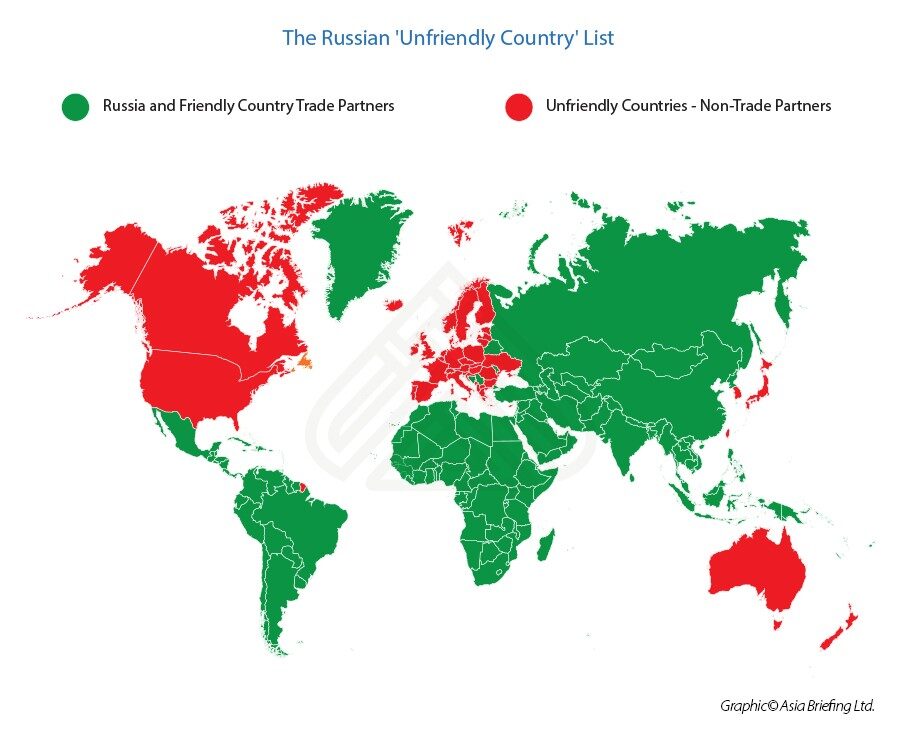Russia began publishing a list of 'unfriendly countries' from May 2021, which was significantly expanded in March 2022. In the map attached, we can see that most of what is collectively known as 'the West" is included in the shape of the United States, Canada, the European Union and United Kingdom, in addition to Asian nations such as Australia and New Zealand, Japan, South Korea and Singapore. A few other countries also make the list. These are all marked in red.
Russia, and the Rest of the World, or what Moscow considers to be 'friendly' countries, is marked in green.
To get a sense of perspective about the potential for the 'Friendly vs UnFriendly' Countries, and their respective GDP growth, I have taken basic data from the IMF, as stated in their most recent forecast for global growth in 2023. This data was extracted in May this year and includes adjustments for the impact of the Ukraine conflict. The basic data read as follows and is based on nominal figures:
Unfriendly Country 2023 GDP Forecast (US$, trillions)
| USA | 20.5 |
| EU | 15.2 |
| UK | 2.80 |
| Australia | 1.37 |
| New Zealand | 0.25 |
| Japan | 5.00 |
| South Korea | 1.67 |
| Singapore | 0.39 |
| Canada | 1.71 |
| Switzerland | 0.79 |
| Norway | 0.40 |
| Taiwan | 0.69 |
| Ukraine | 0.06 |
| Others | 0.62 |
| Total | 51.45 |
In terms of the Friendly Countries, these can conveniently be broken down into specific regions
Friendly Countries2023 GDP Forecast (US$, trillions)
| Asia (minus unfriendly countries) | 23.08 |
| Russia | 1.5 |
| LatAm | 4.6 |
| Middle East | 3.6 |
| Africa | 2.6 |
| Total | 35.38 |
This means that Russia's Friendly country GDP total is roughly 2/3 of the total GDP weight positioned against it.
However, GDP anticipated growth when factored in favors Russia. According to Statistica, growth in the Asian region from 2022 to 2027 is expected be more than double that in the United States and European Union, at 3.52% against 1.5% for the West. That is interesting as it suggests that despite the 'Unfriendly Counties' ability to trade with most of the Russian-Friendly countries, their collective performance will not be as positive in terms of affecting their domestic economies.
Growth in Africa is expected to reach 4.3% over the same period, due in part to the recent African Continental Free Trade Agreement, while in the Middle East, growth is expected at about 5.2% - several nations such as Saudi Arabia, and the UAE are already embarked on Vision 2030 schemes which will see improved significant infrastructure builds and reforms to open up their economies. LatAm it is expected at a more modest 2.5% - but still significantly more than the 'Unfriendly' Nations. Another way of looking at this is to suggest that of all the global trading blocs, Russia has identified the worst performing - West - as deserving of being cast adrift in light of better opportunities elsewhere.
Another factor to keep an eye on is inflation, which is currently running close to 9% in the US and EU, but is about 3% in China, 6.9% in India, and 4.7% in ASEAN. It's less good in the Middle East, with current rates at 13.7%, an average 12.2% in Africa and averaging 10% in LatAm. Clearly, that is going to be a bumpy ride, although rates in Asia appear to be more stable than anywhere else.
In recent televised remarks in Russia, President Putin suggested that Russia and its Allies may overtake the West in both total GDP productivity and growth rates within the next decade (that was met with a collective Russian media moan of "another ten years!"). However it does also suggest that Putin's effective bet against the West to drive ahead a multi-polar, rather than uni-polar (US) lead global society does have legs. It also suggests that Russia has done its homework when it comes to choosing its friends.
The figures shown of course are estimations and projections, and subject to change. As economists like to suggest, "statistics, statistics and damn lies - there is little to choose between them".
As things stand, it seems possible given the coming potential impact on Western nations of inflationary costs eating into productivity that the quoted GDP figures may even be optimistic - many analysts predict stagflation or even recession awaits. But one thing does appear certain - the status of global GDP, its growth and where the power base lies does look as if Putin placed his money on the right horse in what will prove a difficult and complicated race with many twists and turns still to come.




It is a artificial figure to make the economy appear larger, it especially includes money flows like "financial instruments", government and consumer spending. In other words, it emphasizes the money changer's business.
And I didn't need to read the rest of that crap, which serves as a lame excuse why the "high GDP" Western nation suffer from inflation and crisis while "low GDP, single-industry" countries like Russia are doing so well.